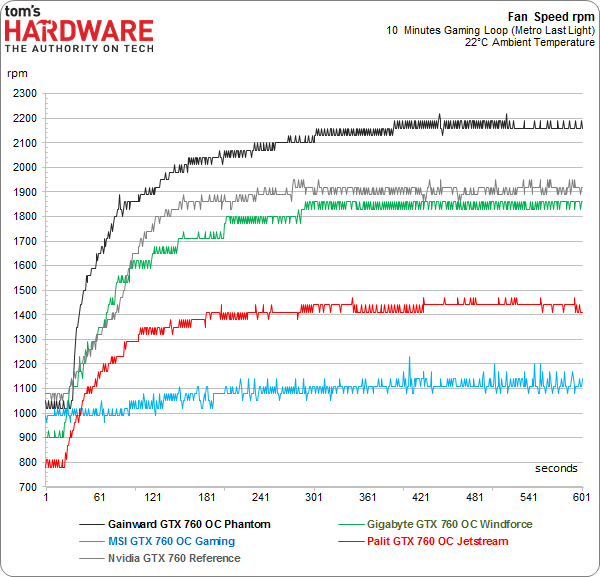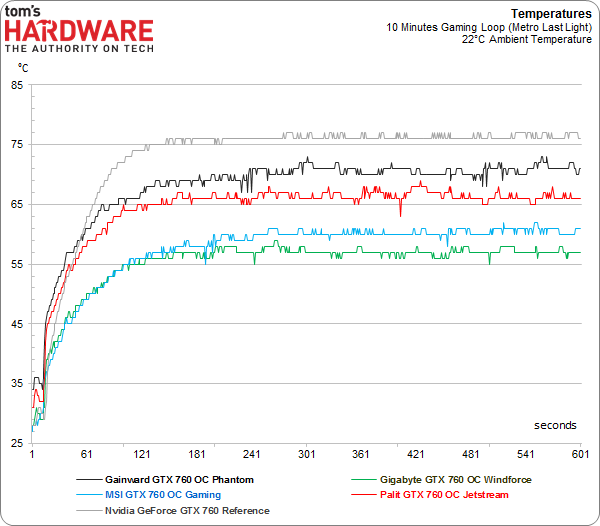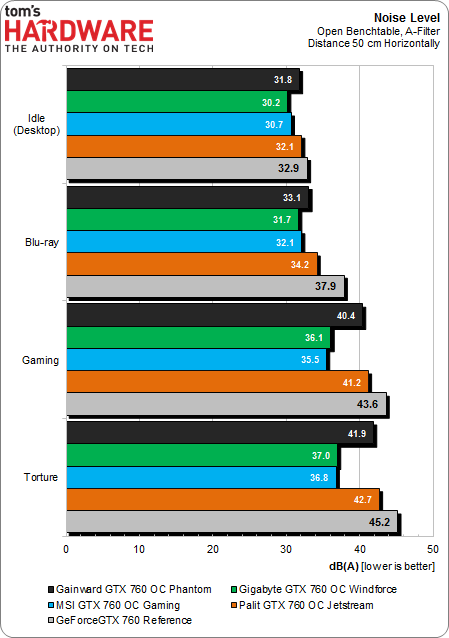GeForce GTX 760 Review: GK104 Shows Up (And Off) At $250
With its last graphics card introduction until the end of Fall, Nvidia isn't trying to impress anyone with groundbreaking performance. Rather, the company is pulling better-than GeForce GTX 660 Ti-class frame rates to a $250 price point, creating value.
Heat, Noise, And Cooling
Fan Speeds
The major variable affecting cooling and, by extension, game performance by virtue of GPU Boost, is fan speed. To make things a little more complicated, we have cards with one, two, and three fans of varying size employing different working principles competing against each other.
This graph tells us that the Gainward Phantom’s two axial fans have to work harder than the others in order to keep the card cool enough. Sadly, this doesn't mean the Phantom runs cooler than the other cards, but we’ll get to that in a moment.
Meanwhile, the three blowers on Gigabyte’s Windforce 3x cooler make a very good impression. True, they don’t spin especially slowly. But still, the card is among the quietest and coolest in this group.
Then there’s Palit’s Jetstream, suffering from the same problem as last year’s GeForce GTX 670 that employed the same cooling solution. Although the loud fans are reined in a little through the fan speed profile, the card remains among the loudest and has to contend with higher temperatures due to the lower fan speeds.
MSI’s TwinFrozr-equipped card, on the other hand, barely has to speed up its fans at all and still offers cooling performance comparable to that of the Gigabyte card.
Heat
Get Tom's Hardware's best news and in-depth reviews, straight to your inbox.
Now that we know how each of the coolers performs with respect to fan speed, let’s see what that means for their cooling performance.
Notably, the two cards built on the GeForce GTX 680's longer PCB stay cooler than the shorter versions. Gigabyte‘s GTX 760 OC Windforce 3x enjoys a small advantage over MSI’s entry, staying 4°C cooler, even though the MSI GTX 760 OC Gaming runs at a lower base clock.
Noise
We measure noise output in a semi-anechoic chamber with the cards running our usual benchmark loop. Measurements are taken at a distance of 50 cm (19.7 inches) perpendicular to the card’s center once it has reached a constant temperature. As before, we use a studio-quality microphone that is better equipped to more accurately record higher-frequency fan noise than conventional sound level measuring devices with a cut-off frequency of 10 kHz. Finally, we opt for the dB(A) filter, since we want our measurements to reflect subjective impressions.
At idle and under partial load, the Gigabyte card is actually quieter than the rest of the field. Under full load, the MSI card takes top honors, albeit by a slim and barely perceptible margin. Meanwhile, the three cards built on the shorter PCB are audibly louder. Like the reference GeForce GTX 670, Nvidia's own 760 fails to impress, remaining quite audible. But again, it looks like most partners are going a route other than the home-grown design.
Palit’s Jetstream cooler is a little quieter than its counterpart on the GTX 670, but still hampered in comparison. Then again, Gainward’s Phantom is barely quieter due to elevated fan speeds. Truth be told, we’re a little disappointed by this cooler. It simply doesn't live up to what we'd expect from something that eats up three expansion slots.
-
SiliconWars This doesn't look faster than the 7950 boost to me. Maybe you should check your scores and update your conclusion to reflect reality?Reply -
pauldh Reply11035777 said:This doesn't look faster than the 7950 boost to me. Maybe you should check your scores and update your conclusion to reflect reality?
Re-read the conclusion in question below. He doesn't say it is faster, he says this card will replace Don's recommendation for best $250 card and displace the 7950 Boost. ie. Don won't be recommending a $300 card that trades blows or barely beats a $250 card. If both were to end up $250, things change.
quote - "A quick reference to Best Graphics Cards For The Money: June 2013 shows that Don is currently recommending the Tahiti-based Radeon HD 7870 for $250. With almost certainty, the GeForce GTX 760 will take that honor next month, displacing the Radeon HD 7950 with Boost at $300 in the process." -
mapesdhs Chris, what is it about the GTX 580 that makes it so slow for the CUDA FluidmarkReply
test, given it does so well for the other CUDA tests, especially iRay and Blender?
Btw, I don't suppose you could include 580 SLI results for the game tests? ;)
Or do you have just the one 580?
My only gripe with the 760 is the misuse of a model number which allows one to
infer it should be quicker than older cards with 'lesser' names (660, etc.) when
infact it's often slower. I really wish NVIDIA would stop releasing products that
exhibit such enormous performance overlap. Given the evolutionary nature of
GPUs, and the time that has passed since the 600s launched, one might
reasonably expect a 760 to beat the 670 too, but it never does. To me, the
price drop is the only thing it has going for it. The endless meddling with shader
numbers, clocks, bus width, etc., creates an utter muddle of performance
response depending on the game. One really has to judge based on the
individual game rather than any general product description or spec summary.
I just hope Skyrim players with 660s don't upgrade on the assumption newer
model names mean better performance, but I expect some will.
Ian.
-
tomfreak GTX760 is an upgrade for GTX460/560 user and of all of that u didnt throw in those cards to bench with. Seriously?Reply -
Novuake Nice review as per usual Chris.Reply
Amazing performance at 250$. The 265bit memory interface does wonders for GK104.
Now I am wondering if there will even be a GTX760ti, while there is a large enough gap in the product stack, I have a feeling there is a chance there may not be a "ti" version.
Anyone know more? -
sarinaide AMD will have to release a new interim Radeon series, the existing family is not to outdated to be stretched to much longer.Reply -
horaciopz So, maybe there will be an GTX 760 ti, for about 300 bucks with the peformance of a GTX 670... Uh? nVidia really should. This remembers the gtx 400 series and 500 series... nVidia is doing it all over again.Reply



